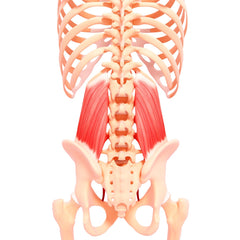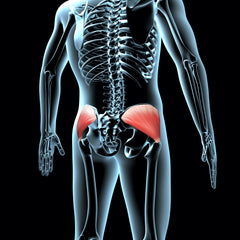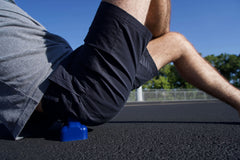Low back pain is an epidemic. The American Chiropractic Association estimates that 80% of Americans will experience back pain in their lives, and about 31 million Americans are experiencing low back pain at any given time [1]. So what are we doing to fight this? We are throwing $50 billion per year in healthcare costs to fix our backs, with limited success [1].
Perhaps the biggest oversight in back pain management is examining muscles. Modern activities like sitting in chairs, driving cars, and lifting weights are very new to the human experience in our evolutionary timeline. Our bodies are not designed for these activities, and our muscles pay the price for it. Muscles should be at the top of the list when examining low back pain, because the treatment is inexpensive, non-invasive, and is easy to maintain.
So here are the 5 muscles that cause pain in the low back area, how to know if they are problems for you, and how to release each muscle from contributing to your pain.
1. Quadratus Lumborum (QL):
Quadratus Lumborum (or "QL" for short) is a deep low back muscle that is crucial for spinal stability, side bending, and overall spine health. The QL muscle is very active in high impact sports to keep the low back sturdy. Along the same lines, the QL can get overworked in high impact sport and can develop tightness as a means of spinal protection.
QL induced pain will manifest right in the low back. Lifting or performing high impact activities will prove uncomfortable. To release this muscle, I recommend massaging with a tool such as the QL Claw, which specializes in Quadratus Lumborum release along with massaging the other 4 muscles on this page.
Watch this video tutorial to effectively release your QL muscle using the QL Claw device.

Quadratus Lumborum Muscle

Quadratus Lumborum Release
2. Psoas:
If you are familiar to low back pain, chance are high you are familiar to Psoas. Psoas is a large hip flexor muscle in the front of your body that connects from low back vertebrae to the top of the femur (upper leg). Psoas functions in swinging your leg forward when walking and running, bringing the knee to the chest, and stabilizing the spine.
Psoas is classically tight in patients who sit a lot, which is most people. If you have a desk job or sit for over 8 hours a day, Psoas should be high on the list of low back pain suspects to investigate.
Psoas can be effectively released using the QL Claw device. To do this, lay belly first on the Claw, placing the large end (the ramp) just above the waistline as shown in the figure below. Breathe deep into the belly, pushing the Claw out on the inhale, and sinking into the Claw on the exhale.
Check out this video tutorial containing both Psoas and Iliacus massage for sitting-induced back pain relief.

Psoas Muscle

Psoas Release
3. Iliacus:
Iliacus tightness goes hand in hand with Psoas tightness. Both the Psoas and Iliacus are hip flexor muscles that get tight from sitting, and both should be investigated for low back pain together.
Iliacus release is one of the QL Claw's specialties. To massage the Iliacus muscle, place the small portion (the "trigger") of the Claw right on the inside face of the hip bone, as shown in the figure below. A great tutorial for Iliacus release is on this page.

Iliacus Muscle

Iliacus Release
4. Gluteus Medius:
The Gluteus Medius muscle is an upper glute muscle that is active during walking, high impact sports, lifting, and stabilizing while standing. Glute Medius fires when standing on one leg to prevent you from tipping over - your right Gluteus Medius is active when standing on your right leg to prevent you from falling to the left.
Gluteus Medius works (and can get overworked) when you are on your feet all day. If your low back pain is triggered by a long hike, moving houses, or simply being on your feet all day, Gluteus Medius is a likely culprit.
The best way to massage the Gluteus Medius for low back pain relief is with the QL Claw device (shocking, right?). QL Claw is great for this because is does deep tissue massage, it has a ramp for improved comfort and angle of attack, and the trigger is planted to the ground so your body can work the muscle with greater control.
A more detailed Gluteus Medius release tutorial can be found on this page.

Gluteus Medius Muscle

Gluteus Medius Release
5. Piriformis:
The Piriformis is a deep butt muscle that is very unforgiving when tight. It can manifest as tailbone or outer glute pain, and can be worsened by long periods of sitting.
Piriformis tightness can be triggered by a quick athletic movement that is out of ones league. For example, if you make a quick cut playing in the family Turkey Bowl football game for the first time in years, Piriformis may lock up. After Piriformis is tight, simple activities like sitting down for extended periods of time and bending over may prove painful.
If you're looking to massage the Piriformis, look no further than QL Claw. QL Claw is great for Piriformis release because (like Glute Medius) it stays on the ground, it has a comfortable ramp to access the muscle optimally, and it has a trigger to dig into the muscle as deep as necessary.
Check out a great Piriformis muscle release tutorial here.

Piriformis Muscle

Piriformis Release
QL Claw was designed around these 5 muscles, as a tool to massage away any muscle-induced back pain. Own your muscles and buy your QL Claw today!
Sources:
[1] “Patients.” American Chiropractic Association, www.acatoday.org/Patients/What-is-Chiropractic/Back-Pain-Facts-and-Statistics.
[2] Donnelly, Joseph M. Travell, Simons & Simons Myofascial Pain and Dysfunction: the Trigger Point Manual. 3rd ed., Wolters Kluwer Health, 2019.
[3] Davies, Clair, and Amber Davies. The Trigger Point Therapy Workbook: Your Self-Treatment Guide for Pain Relief. 3rd ed., New Harbinger Publications, Inc., 2013.


